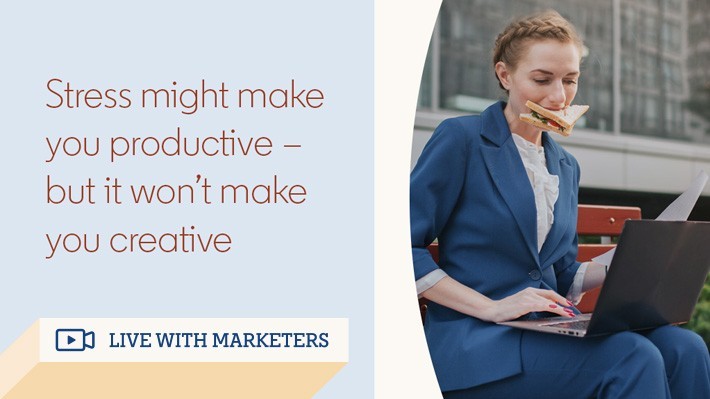Stress might make you productive – but it won’t make you creative
Can you be creative when you’re feeling stressed? For a worrying proportion of marketers, that’s a question they have to confront on a daily basis. In the latest Marketer Happiness Report from MarketingProfs, a third say that work pressure means that they are rarely or never able to focus – and roughly the same number say that they frequently find it difficult to complete tasks because of interruptions. It certainly doesn’t feel like a recipe for fresh, original thinking. But how realistic is it to change things? Ours may be a creative profession, but it’s also a profession with a lot of deadlines, data and details to manage. How much space can we afford to make for creativity – and how badly do we need to?
Smart, humane managers recognise how important this issue is. They see the link between wellbeing and creativity and they don’t take either of these things for granted where their teams are concerned. It was fantastic to have three such managers on the Life with Marketers sofa with me last month to discuss Talent, Creativity and the Future of Marketing Teams: LinkedIn Learning’s Director of Marketing for EMEA and APAC, Namrata Murlidhar Anand, HP’s Head of Social Media for EMEA, Mohammed Zohny and Teamwork’s Head of Marketing Raymond Coppinger.
I put my guests on the spot about their definition of creativity and what it takes to cultivate it in a team – and I was particularly interested to hear their views on how you balance pressure and creativity within an organisation. It’s a question that’s become more complicated recently because of a growing body of thinking that argues the relationship between stress and creativity is more complicated than we’ve been led to believe.
Do you come up with more ideas when you’re under pressure?
The likes of Harvard Business Review and HubSpot have recently published articles arguing that the requirement to shift between tasks might not be as damaging to creativity as we instinctively assume. Both report on research from the Columbia Business School that showed people who were forced to switch between different tasks actually came up with more original ideas than those in more control of their time. Evidence it seems that being forced to take a break before you run out of concentration and creative steam can keep your thinking fresh and efficient.
There’s also the argument that a certain degree of pressure comes from having a job that you value and work that you consider important – an idea explored by Harvard Business School Director of Research Teresa Amabile in her book The Progress Principle. It’s relatively easy to avoid pressure in your career if you set out with that as your objective. But are you then going to be in positions that inspire you to think creatively – and give you the opportunity to do so?
Take these different studies together and it’s becoming easier to make a case for keeping marketers’ schedules frenetic and still expecting them to come up with the creative goods – having your creativity cake and still eating it. But is this wishful thinking? Is it a bit too convenient that as time and space for thinking gets squeezed out of our schedules, we find some evidence that we didn’t really need that time and space anyway?
I loved the answers that my guests gave when I asked them if you can be stressed and creative. And what I particularly loved about them was that they were fully aware of the latest research. They just didn’t accept its conclusions. It’s not that the data’s wrong – it’s just that we’re slightly missing the point about creativity in the first place.
The crucial difference between creativity and productivity
When considering what marketers really need to be creative, it’s vital that we understand the difference between creativity and productivity. It’s perfectly possible to be productive, energetic and original when jumping between tasks. Surface-level creativity if you like. But it’s a lot harder to re-imagine the scope of what you are doing in a creative way. Constraints can help trigger creativity but they still constrain what the output of that creativity can be. Sometimes, and more often than we’re allowing at the moment, we need to reprioritise a deeper form of creative thinking; one that redefines tasks and objectives, and follows through on ideas rather than just generating them.
I’ve experienced myself how leaping between an ad campaign, a piece of video content and a blog post can help you to keep approaching each of these things from a fresh angle. It can prevent your thinking getting stale and perhaps most importantly, give you the momentum and impetus to get each task finished by forcing you to work in tight, creative bursts. I actually enjoy working this way – and it’s just as well because, like many marketers, that’s often the reality.
I can totally buy the argument that working like this will enable me to produce an ad campaign that connects with my audience, a blog post that says something unexpected, and a video that makes people laugh. And these are all very worthy creative deliverables. However, working like this won’t give as much time to sit back, consider my end-objectives, try to feel things from my audience’s point of view, and ask if these deliverables are really the most creative solution to what my brand needs. Could I be doing something completely different, completely unexpected, that would captivate them in a wholly different way? When you’ve got deadlines and meetings boxing in your attention, you don’t think outside the box.
Why thinking outside the box matters in B2B
LinkedIn’s B2B Institute last week published a fascinating new study from Les Binet and Peter Field that proves B2B marketers can’t just be satisfied by making people aware of their brand. The most successful businesses are more ambitious with their marketing. They set out to achieve brand fame, which delivers massive benefits every time they run a lead generation campaign or tactical marketing.
What’s the key to achieving brand fame? It’s rarely just a case of making a better ad, or a better piece of content. Famous B2B brands, like famous B2C ones, do things that have never been done before. They play outside the perceived rules. They startle audiences. They get talked about. This kind of creativity doesn’t come from somebody jumping between predetermined tasks. It comes from somebody (in fact, lots of people) sitting back, asking themselves what else they could be doing, and letting imagination steer them towards unexpected answers.
Don’t settle for superficial creativity
Mohammed Zohny quoting David Lynch during our conversation reminded me of a similar debate on creativity that’s been raging in the world of design and management consultancy over the past couple of years. Design Thinking is a concept developed by management thinkers with the good intention of embedding creativity throughout an organisation. It moves people efficiently through a series of five steps (empathise, define, ideate, prototype, test) that are modelled on how designers approach a brief and are meant to help produce a creative result at the end of it. Design Thinking is designed to make creativity more repeatable and reliable so that it fits in with the way a business works.
There’s just one problem – more and more designers seem to hate the idea. They may have been flattered when design thinking first emerged but they’ve increasingly come to realise that constraining the way design works squeezes the creativity out of it. It just doesn’t allow time and space for designers to let their minds wander, mash together all kinds of different ideas and come up with something completely unexpected – perhaps even to them. This argument is put brilliantly (and very bluntly) in a punchy keynote from the designer Natasha Jen. It’s one that I think any creative-minded marketer will identify with. It’s a rallying call against letting the definition of true creativity slip just to fit in with a pressing timetable.
Marketing needs leaders that value creative thinking
It’s true that we can deliver creative results in short, sharp bursts when our minds are intensely focused and we’re walking that mental-emotional high-wire between feeling the meaning in our work and feeling frozen by the pressure to produce it. But that doesn’t make this the best approach to creativity in marketing – and it doesn’t mean that it produces the most creative results.
If we’re ambitious about what we do, and we’re serious about the value of creativity, then we’re going to have to make space for a different level of thinking within our organisations. And we’re going to need marketing leaders like Ray, Namrata and Mohammed who are willing to prioritise making that space available when we need it. It’s a balancing act, given the very real pressures and deadlines that any marketing team faces. But just because it’s challenging doesn’t mean it no longer matters.
Get more insight on managing marketers and leaving room for creativity in the full Live with Marketers episode: Talent, Creativity and the Future of Marketing Teams, available on-demand now.



